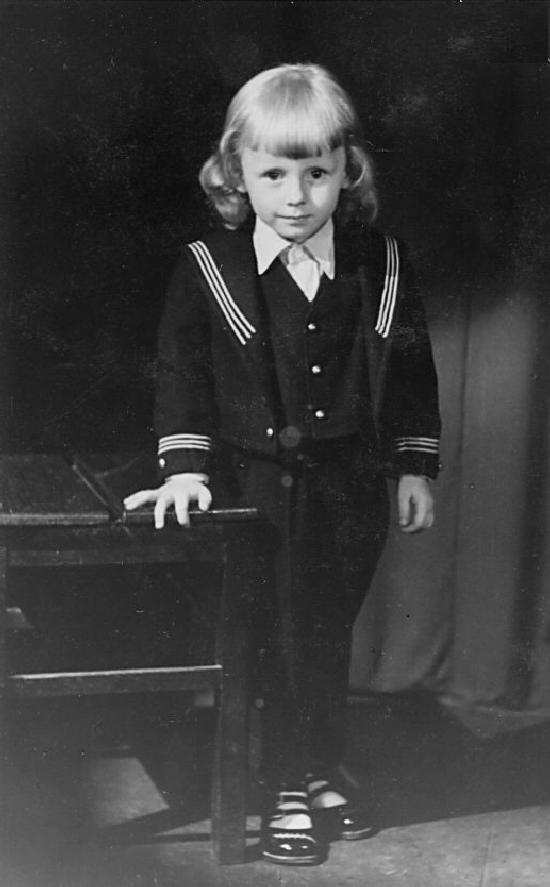
Multiple Strap Shoes: Number of Straps

Figure 1.--This unidentified German boy wears double-strap patent leather shoes. We are unsure just when the portrait was taken. I am unsure just how to date the image. I would guess the portait was taken about 1930, but it is a difficult one to assess. A sailor suit could be worn as late 1940s or early 1950s, but the style here seems a non-traditionl style more likely to be wirn in the 1920s or early 30s than the 40s and 50s. I have seen pretty late pictures with sailor suits. The white border you can have in the 1920s as well as in the 1940s and 1950s. The hair seems unlikely for the 1950s. The strap shoes I am unsure about.
|
|
There were a variety of other styles of strap shoes. Thesingle bar strap shoe becme the standard in the 20th century, especially after World War I (1914-18). We note many strap shoes in the late 19th century with multiple straps. This was primarily a style for very young children, although women's shoes were sometimes done with multiple straps. These multiple straps shoes were a common dress style for younger childern. Older children usually wore high-top shoes.These were usually two-bar shoes, but we have seen these shoes with three or more bars, normally without a supporting center strap. The shoes with the supporting center strap became more of a casual play style, but not always. After the turn of the century the straps became standardized at either one or two and you rarely see children with shoes that had three or more bars. The single strap style eventually became the standard.
Number of Multiple Bars
There were a variety of styles of strap shoes. The primary but not the only variant was the number of straps. We note many strap shoes in the late 19th century with multiple straps. This was primarily a style for very young children, although women's shoes were sometimes done with multiple straps. These multiple straps shoes were a common dress style for younger childern. Older children usually wore high-top shoes.
The single bar strap shoe becme the standard in the 20th century, especially after World War I (1914-18). There were different styles. The most important were the ankle strap and the instep strap. The classic strap shoe is a one bar instep strap. The most common style of strap shoe had a strap which crossed the foot at the instep. This is the first style of strap shoes to appear and is the classic style for the shoe. The width of the strap varies on this style. Some strap were quite narrow, others had very wide straps. These shoes were worn by younger children throughout the 19the century. They were first commonly worn by boys about the turn of the 19th century with long pants skeleton suits. After the 1840s they were mostly worn by very young boys ad girls, nut increased in popularity in the 1890s when they began to be worn with Fauntleroy suits and other dressy children's wear. They were worn by both boys and girls in the early 20th century--especially boys from affluent families. Hosierty styles varied.
Double bars
The most common type of double bar shoes were two-bar shoes. After the turn of the century the straps became standardized at either one or two and you rarely see children with shoes that had three or more bars. The single strap style eventually became the standard. A good example of a boy wearing a double strap shoe is Hugh James about 1905-10.
Triple bars
We have seen strap shoes with three bars. They were not as common as the single and double bar shoes, but they were not rare. This was primarily a late 19th century style, but we have noted them after the turn-of-the-century as well.
Four and more bars
We have seen some of these shoes with four or more straps. Some became almost high top shoes. These strap shoes with the higher number of straps were a late 19th century style. We think these strap shoes with nymerous straps were more common for girls than boys, but we see both wearing them. A good example is an American girl in the 1900s. Most of the boys we see wearing them were quite small.
These multiple strap shoes were normally worn without a supporting center strap. The shoes with the supporting center strap became more of a casual play style, but not always. This style of dress strap shoe was normally worn by girls. Both boys and girls wore the play sandal style.
HBC

Navigate the Boys' Historical Clothing Strap Shoe-related Pages:
[Return to the Main multiple strap shoe type page]
[Return to the Main sandal page]
[White knee socks]
[Sand shoes]
[Pinafores]
[Smocks]
[Kilts]
[Ringlet curls]
[Fauntleroy suits]
[Buster Brown suits]
[Ring bearers]
Navigate the Boys' Historical Clothing Web Site:
[Introduction]
[Activities]
[Bibliographies]
[Biographies]
[Chronology]
[Clothing styles]
[Countries]
[Girls]
[Contributions]
[Essays]
[FAQs]
[Glossaries]
[Satellite sites]
[Tools]
[Boys' Clothing Home]
Created: 8:55 PM 10/15/2005
Last updated: 1:29 AM 1/29/2006



